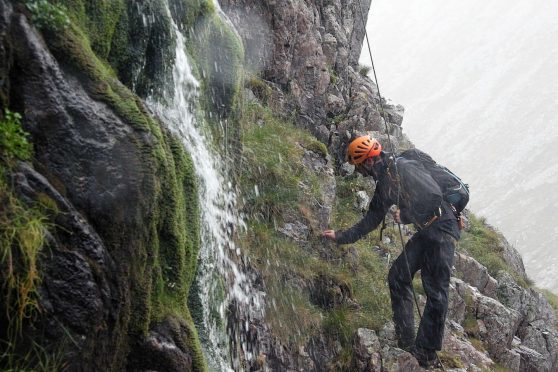Heavy rain and thick mist has failed to deter scientists and climbers carrying out a major study of the UK’s highest peak this week.
Around 20 botanists, geologists, mountain guides and trainee rangers have been dangling off ropes and scaling slippery rocks to reach some of Ben Nevis’s hidden treasures.
They are taking part in the third and final year of the North Face Survey – an ambitious project studying the flora and geology of more than 300 acres of the 4,412ft mountain.
And they have already been rewarded with some interesting finds.
Mike Pescod, of Fort William-based Abacus Mountain Guides, said the discoveries began during training before the survey even began.
He said: “We found a new area of Wavy Meadow Grass, bigger than either of the two previously known locations with 500 clumps.
“Since the North Face is a SSSI (Site of Special Scientific Interest) and these nationally rare plants grow in very few places in the country, this is a very important find.
“It also shows that the vascular assemblage on Ben Nevis is in favourable condition – that means the flowers are doing OK.”
He added that they had also updated the geological model of Ben Nevis by recording a huge amount of data.
The main areas surveyed so far include Little Brenva Face, Orion Face and Observatory Gully.
Mr Pescod described abseiling down Green Gully to examine the plants.
He said: ” This is a very popular winter climb that I have enjoyed climbing many times.
“I don’t know of anyone that has descended it in summer.
“It is wet, loose and full of rare plants, including Arctic Mouse Ear, Starwort Mouse Ear, Alpine speedwell, Highland Saxifrage and Alpine Meadow Grass.”
He added that one of the best finds so far was a new location for Tufted Saxifrage.
Nevis Landscape Partnership (NLP) has been leading the three-year survey funded by the Heritage Lottery Fund and Scottish Natural Heritage.
NLP environmental projects officer Lewis Pate said: “The distribution of the rare plants was far greater than anybody had estimated.
“When this survey was first discussed seven or eight years ago, the original thoughts were to translocate plants onto the Ben to augment the existing population, but they were all there.
“They were just in very hard to reach places.”
The main aims of the study are to create a 3D map of Ben Nevis, raise the profile of the mountain and look at the affect of climate change.
